Event Scale Analysis of Streamflow Response to Wildfire in Oregon, 2020
Abstract
1. Introduction
- To what degree does the arrangement of burn severity patches influence streamflow response at event scales?
- Are changes to event runoff ratios more detectable using daily values or using instantaneous values for individual events?
2. Materials and Methods
2.1. Context of 2020 Labor Day Fires
2.2. Study Area Overview
2.3. Individual Watershed Characteristics
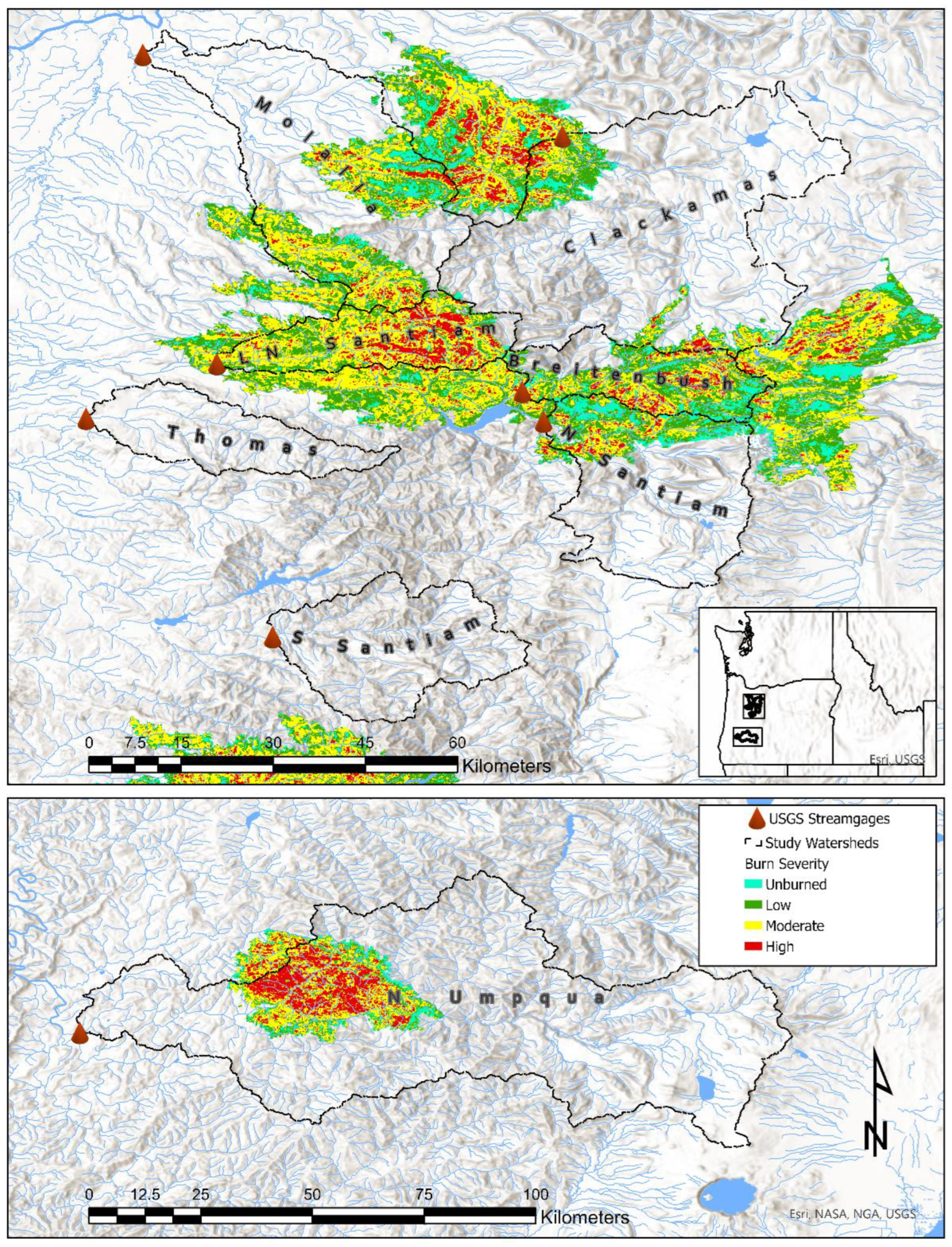
| Watershed | Area (km2) | Mean Basin Elevation (m) | Mean Basin Slope (degrees) | Mean Annual Precip. (mm) | Mean Soil Perm. (mm/hr) | Permeable Geology (%) | Forested (%) |
|---|---|---|---|---|---|---|---|
| Clackamas | 1266 | 1760 | 14.1 | 1851 | 88 | 66.3 | 89.9 |
| LN Santiam | 287 | 817 | 21.7 | 2235 | 60 | 6.1 | 95.7 |
| Breitenbush | 274 | 1155 | 21.6 | 2057 | 115 | 54.5 | 90.0 |
| N Umpqua | 3515 | 1005 | 27.0 | 1496 | 59 | 26.0 | 88.4 |
| Molalla | 841 | 588 | 13.4 | 1958 | 50 | 25.8 | 82.3 |
| N Santiam | 558 | 1258 | 14.7 | 2184 | 148 | 85.0 | 87.1 |
| S Santiam | 451 | 899 | 19.7 | 2143 | 50 | 5.6 | 92.6 |
| Thomas | 285 | 557 | 13.7 | 2045 | 29 | 4.7 | 80.4 |
2.4. Precipitation and Flow
2.5. Streamflow Metrics
2.6. Landscape Metrics
2.7. Comparison of Pre- and Post-Fire Streamflow Response
2.8. Hydrograph Separation
2.9. Selection of Storm Events
- Starting threshold was set to 7 mm of rainfall depth,
- A minimum event gap of 1 day,
- A minimum event duration of 2 days,
- Ending threshold was varied between 2 mm and 4 mm of runoff depth depending on watershed area and remained below the threshold for at least 1 day.
- Starting threshold was set to 0.1 mm of rainfall depth,
- A minimum gap of 6 hours,
- A minimum duration of 6 hours,
- The ending threshold was varied using precipitation or runoff depth for each event based on the visual inspection of the recession limb of the hydrograph.
2.10. GIS Analysis
2.11. Statistical Analysis
3. Results
3.1. Event Runoff Ratio (Qr)
3.2. Event Peak Runoff Ratio (Qp)
4. Discussion
4.1. Event Runoff Ratio (Qr)
4.2. Event Peak Runoff Ratio (Qp)
4.3. Landscape Metrics
4.4. Limitations
5. Conclusions
Author Contributions
Funding
Data Availability Statement
Acknowledgments
Conflicts of Interest
References
- Furniss, M.J.; Staab, B.P.; Hazelhurst, S.; Clifton, C.F.; Roby, K.B.; Ilhadrt, B.L.; Todd, A.H.; Reid, L.M.; Hines, S.J.; Bennett, K.A.; et al. Water, Climate Change, and Forests: Watershed Stewardship for a Changing Climate; General Technical Report PNW-GTR-812; Department of Agriculture, Forest Service, Pacific Northwest Research Station: Portland, OR, USA, 2010; 75p. [Google Scholar] [CrossRef]
- Neary, D.G.; Gottfried, G.J.; DeBano, L.F.; Tecle, A. Impacts of Fire on Watershed Resources. J. Ariz. Nev. Acad. Sci. 2003, 35, 23–41. [Google Scholar]
- Hallema, D.; Sun, G.; Caldwell, P.; Robinne, F.-N.; Bladon, K.D.; Norman, S.; Liu, Y.; Cohen, E.C.; McNulty, S. Wildland Fire Impacts on Water Yield across the Contiguous United States; General Technical Report SRS-238; Department of Agriculture Forest Service, Southern Research Station: Asheville, NC, USA, 2019; pp. 1–118. [Google Scholar] [CrossRef]
- Rust, A.J.; Hogue, T.S.; Saxe, S.; McCray, J. Post-fire water-quality response in the western United States. Int. J. Wildland Fire 2018, 27, 203–216. [Google Scholar] [CrossRef]
- Chen, J.; Chang, H. A Review of Wildfire Impacts on Stream Temperature and Turbidity across Scales. Prog. Phys. Geogr. 2022. [Google Scholar] [CrossRef]
- Moody, J.A.; Martin, D.A. Post-fire, rainfall intensity-peak discharge relations for three mountainous watersheds in the western USA. Hydrol. Process. 2001, 15, 13. [Google Scholar] [CrossRef]
- Eidenshink, J.; Schwind, B.; Brewer, K.; Zhu, Z.-L.; Quayle, B.; Howard, S. A Project for Monitoring Trends in Burn Severity. Fire Ecol. 2007, 3, 3–21. [Google Scholar] [CrossRef]
- Keeley, J.E. Fire intensity, fire severity and burn severity: A brief review and suggested usage. Int. J. Wildland Fire 2009, 18, 116–126. [Google Scholar] [CrossRef]
- Scott, D.F.; Versfeld, D.B.; Lesch, W. Erosion and sediment yield in relation to afforestation and fire in the mountains of the western cape province, South Africa. S. Afr. Geogr. J. 1998, 80, 52–59. [Google Scholar] [CrossRef]
- Robichaud, P. Fire effects on infiltration rates after prescribed fire in Northern Rocky Mountain forests, USA. J. Hydrol. 2000, 231–232, 220–229. [Google Scholar] [CrossRef]
- Moody, J.A.; Shakesby, R.A.; Robichaud, P.R.; Cannon, S.H.; Martin, D.A. Current research issues related to post-wildfire runoff and erosion processes. Earth-Sci. Rev. 2013, 122, 10–37. [Google Scholar] [CrossRef]
- Mataix-Solera, J.; Cerdà, A.; Arcenegui, V.; Jordán, A.; Zavala, L.M. Fire effects on soil aggregation: A review. Earth Sci. Rev. 2011, 109, 44–60. [Google Scholar] [CrossRef]
- Certini, G. Effects of fire on properties of forest soils: A review. Oecologia 2005, 143, 1–10. [Google Scholar] [CrossRef]
- Huffman, E.L.; MacDonald, L.H.; Stednick, J.D. Strength and persistence of fire-induced soil hydrophobicity under ponderosa and lodgepole pine, Colorado Front Range. Hydrol. Process. 2001, 15, 2877–2892. [Google Scholar] [CrossRef]
- Doerr, S.H.; Shakesby, R.A.; Walsh, R.P. Spatial variability of soil hydrophobicity in fire-prone eucalyptus and pine forests, Portugal. Soil Sci. 1998, 163, 313–324. [Google Scholar] [CrossRef]
- Cocke, A.E.; Fulé, P.Z.; Crouse, J.E. Comparison of burn severity assessments using Differenced Normalized Burn Ratio and ground data. Int. J. Wildland Fire 2005, 14, 189–198. [Google Scholar] [CrossRef]
- Picotte, J.J.; Bhattarai, K.; Howard, D.; Lecker, J.; Epting, J.; Quayle, B.; Benson, N.; Nelson, K. Changes to the Monitoring Trends in Burn Severity program mapping production procedures and data products. Fire Ecol. 2020, 16, 16. [Google Scholar] [CrossRef]
- Shakesby, R.A.; Doerr, S.H. Wildfire as a Hydrological and Geomorphological Agent. Earth Sci. Rev. 2006, 74, 269–307. [Google Scholar] [CrossRef]
- Kinoshita, A.M.; Hogue, T.S. Spatial and temporal controls on post-fire hydrologic recovery in Southern California watersheds. Fuel Energy Abstr. 2011, 87, 240–252. [Google Scholar] [CrossRef]
- Bart, R.R.; Tague, C.L. The impact of wildfire on baseflow recession rates in California. Hydrol. Process. 2017, 31, 1662–1673. [Google Scholar] [CrossRef]
- Westerling, A.L.; Hidalgo, H.G.; Cayan, D.R.; Swetnam, T.W. Warming and Earlier Spring Increase Western U.S. Forest Wildfire Activity. Science 2006, 313, 940–943. [Google Scholar] [CrossRef]
- Holden, Z.A.; Luce, C.H.; Crimmins, M.A.; Morgan, P. Wildfire extent and severity correlated with annual streamflow distribution and timing in the Pacific Northwest, USA (1984–2005). Ecohydrology 2011, 5, 677–684. [Google Scholar] [CrossRef]
- Moody, J.A.; Martin, D.A.; Haire, S.L.; Kinner, D.A. Linking runoff response to burn severity after a wildfire. Hydrol. Process. 2007, 22, 2063–2074. [Google Scholar] [CrossRef]
- Ortíz-Rodríguez, A.J.; Muñoz-Robles, C.; Borselli, L. Changes in connectivity and hydrological efficiency following wildland fires in Sierra Madre Oriental, Mexico. Sci. Total Environ. 2018, 655, 112–128. [Google Scholar] [CrossRef]
- Kutiel, P.; Lavee, H.; Segev, M.; Benyamini, Y. The effect of fire-induced surface heterogeneity on rainfall-runoff-erosion relationships in an eastern Mediterranean ecosystem, Israel. CATENA 1995, 25, 77–87. [Google Scholar] [CrossRef]
- Cawson, J.G.; Sheridan, G.J.; Smith, H.G.; Lane, P.N.J. Effects of fire severity and burn patchiness on hillslope-scale surface runoff, erosion and hydrologic connectivity in a prescribed burn. For. Ecol. Manag. 2013, 310, 219–233. [Google Scholar] [CrossRef]
- Bélisle, M. Measuring Landscape Connectivity: The Challenge of Behavioral Landscape Ecology. Ecology 2005, 86, 1988–1995. [Google Scholar] [CrossRef]
- Ebel, B.A.; Mirus, B.B. Disturbance Hydrology: Challenges and Opportunities. Hydrol. Process. 2014, 28, 5140–5148. [Google Scholar] [CrossRef]
- Williams, C.J.; Pierson, F.B.; Robichaud, P.R.; Al-Hamdan, O.Z.; Boll, J.; Strand, E.K. Structural and functional connectivity as a driver of hillslope erosion following disturbance. Int. J. Wildland Fire 2016, 25, 306. [Google Scholar] [CrossRef]
- Singh, V.P. Effect of spatial and temporal variability in rainfall and watershed characteristics on stream flow hydrograph. Hydrol. Process. 1997, 11, 1649–1669. [Google Scholar] [CrossRef]
- McGarigal, K. Landscape Pattern Metrics. In Wiley StatsRef: Statistics Reference Online; John Wiley & Sons, Ltd.: Hoboken, NJ, USA, 2014; ISBN 978-1-118-44511-2. [Google Scholar]
- Riitters, K.H.; O’Neill, R.V.; Hunsaker, C.T.; Wickham, J.D.; Yankee, D.H.; Timmins, S.P.; Jones, K.B.; Jackson, B.L. A factor analysis of landscape pattern and structure metrics. Landsc. Ecol. 1995, 10, 23–39. [Google Scholar] [CrossRef]
- Lee, S.-W.; Lee, M.-B.; Lee, Y.-G.; Won, M.-S.; Kim, J.-J.; Hong, S.-K. Relationship between landscape structure and burn severity at the landscape and class levels in Samchuck, South Korea. For. Ecol. Manag. 2009, 258, 1594–1604. [Google Scholar] [CrossRef]
- Lloret, F.; Calvo, E.; Pons, X.; Díaz-Delgado, R. Wildfires and landscape patterns in the Eastern Iberian Peninsula. Landsc. Ecol. 2002, 17, 745–759. [Google Scholar] [CrossRef]
- Tran, B.N.; Tanase, M.A.; Bennett, L.T.; Aponte, C. High-severity wildfires in temperate Australian forests have increased in extent and aggregation in recent decades. PLoS ONE 2020, 15, e0242484. [Google Scholar] [CrossRef]
- Woods, S.W.; Birkas, A.; Ahl, R. Spatial variability of soil hydrophobicity after wildfires in Montana and Colorado. Geomorphology 2007, 86, 465–479. [Google Scholar] [CrossRef]
- Boer, M.; Puigdefábregas, J. Effects of spatially structured vegetation patterns on hillslope erosion in a semiarid Mediterranean environment: A simulation study. Earth Surf. Process. Landf. 2005, 30, 149–167. [Google Scholar] [CrossRef]
- Telfer, L. Exploring Hydrologic Responses to Different Wildfire Spatial Patterns Through the Lens of Computational Modeling. Master’s Thesis, Boise State University, Boise, ID, USA. December 2021. [CrossRef]
- McMahon, G.; Bales, J.D.; Coles, J.F.; Giddings, E.M.P.; Zappia, H. Use of stage data to characterize hydrologic conditions in an urbanizing environment. JAWRA J. Am. Water Resour. Assoc. 2003, 39, 15291546. [Google Scholar] [CrossRef]
- Zhou, T.; Wu, J.; Peng, S. Assessing the effects of landscape pattern on river water quality at multiple scales: A case study of the Dongjiang River watershed, China. Ecol. Indic. 2012, 23, 166–175. [Google Scholar] [CrossRef]
- Chang, H.; Makido, Y.; Foster, E. Effects of land use change, wetland fragmentation, and best management practices on total suspended solids concentrations in an urbanizing Oregon watershed, USA. J. Environ. Manag. 2021, 282, 111962. [Google Scholar] [CrossRef]
- Van Nieuwenhuyse, B.H.J.; Antoine, M.; Wyseure, G.; Govers, G. Pattern-process relationships in surface hydrology: Hydrological connectivity expressed in landscape metrics. Hydrol. Process. 2011, 25, 3760–3773. [Google Scholar] [CrossRef]
- Li, H.; Wu, J. Use and misuse of landscape indices. Landsc. Ecol. 2004, 19, 389–399. [Google Scholar] [CrossRef]
- Higuera, P.E.; Abatzoglou, J.T. Record-setting climate enabled the extraordinary 2020 fire season in the western United States. Glob. Chang. Biol. 2021, 27, 1–2. [Google Scholar] [CrossRef]
- Oregon Office of Emergency Management 2020 Oregon Wildfire Spotlight. Available online: https://storymaps.arcgis.com/stories/6e1e42989d1b4beb809223d5430a3750 (accessed on 20 December 2021).
- Morris, W.G. Forest Fires in Western Oregon and Western Washington. Or. Hist. Q. 1934, 35, 313–339. [Google Scholar]
- Tague, C.; Grant, G.E. A Geological Framework for Interpreting the Low-Flow Regimes of Cascade Streams, Willamette River Basin, Oregon. Water Resour. Res. 2004, 40, W04303. [Google Scholar] [CrossRef]
- Wallick, J.R.; O’Connor, J.E.; Anderson, S.; Keith, M.K.; Cannon, C.; Risley, J.C. Channel Change and Bed-Material Transport in the Umpqua River Basin, Oregon; Scientific Investigations Report; U.S. Geological Survey: Reston, VA, USA, 2011; Volume 5041, p. 124. [Google Scholar]
- Schruben, P.G.; Arndt, R.E.; Bawiec, W.J. Geology of the Conterminous United States at 1:125,000 Scale—A Digital Representation of the 1974 P.B. King and H.M. Beikman Map. Available online: https://pubs.usgs.gov/dds/dds11/ (accessed on 17 February 2022).
- Soil Survey Staff, Natural Resources Conservation Service, United States Department of Agriculture. Web Soil Survey. Available online: https://websoilsurvey.nrcs.usda.gov/ (accessed on 2 February 2022).
- Gannett, M.W. (Ed.) Ground-Water Hydrology of the Upper Klamath Basin, Oregon and California; Scientific Investigations Report; Geological Survey (U.S.): Portland, OR, USA; U.S. Department of the Interior: Washington, DC, USA; U.S. Geological Survey: Reston, VA, USA, 2007. [Google Scholar]
- Jefferson, A.; Grant, G.E.; Lewis, S.L.; Lancaster, S.T. Coevolution of Hydrology and Topography on a Basalt Landscape in the Oregon Cascade Range, USA. Earth Surf. Process. Landf. 2010, 35, 803–816. [Google Scholar] [CrossRef]
- Chang, H.; Jung, I.-W. Spatial and temporal changes in runoff caused by climate change in a complex large river basin in Oregon. J. Hydrol. 2010, 388, 186–207. [Google Scholar] [CrossRef]
- Parsons, A.; Robichaud, P.; Lewis, S.; Napper, C. Field Guide for Mapping Post-Fire Soil Burn Severity; General Technical Report RMRS-GTR-243; U.S. Department of Agriculture, Forest Service, Rocky Mountain Research Station: Collins, CO, USA, 2010; Volume 243, 49p. [Google Scholar]
- Ries, K.G., III; Newson, J.K.; Smith, M.J.; Guthrie, J.D.; Steeves, P.A.; Haluska, T.; Kolb, K.; Thompson, R.F.; Santoro, R.D.; Vraga, H.W. StreamStats, Version 4; Fact Sheet; U.S. Geological Survey: Reston, VA, USA, 2017; Volume 3046. [Google Scholar]
- Robbins, W.G. Oregon and Climate Change: The Age of Megafires in the American West. Or. Hist. Q. 2021, 122, 250–277. [Google Scholar] [CrossRef]
- Sobieszczyk, S. Using Turbidity Monitoring and LiDAR-Derived Imagery to Investigate Sources of Suspended Sediment in the Little North Santiam River Basin, Oregon, Winter 2009–2010. Master’s Thesis, Portland State University, Portland, OR, USA, 2010. [Google Scholar] [CrossRef][Green Version]
- White, C. Geology of the Breitenbush Hot Springs Quadrangle, Oregon; Department of Geology and Mineral Industries: Portland, OR, USA, 1980. [Google Scholar]
- O’Connor, J.E.; Sarna-Wojcicki, A.; Wozniak, K.C.; Polette, D.J.; Fleck, R.J. Origin, Extent, and Thickness of Quaternary Geologic Units in the Willamette Valley, Oregon; US Geological Survey Professional Paper; U.S. Geological Survey: Portland, OR, USA, 2001; pp. 1–40. [Google Scholar]
- PRISM Climate Group, Oregon State University. Available online: https://prism.oregonstate.edu/ (accessed on 12 January 2022).
- Hart, E.; Bell, K. Prism: Access Data from The Oregon State Prism Climate Project 2015. Available online: https://zenodo.org/record/33663 (accessed on 27 July 2022).
- Hirsch, R.M.; De Cicco, L.A. User Guide to Exploration and Graphics for RivEr Trends (EGRET) and DataRetrieval: R Packages for Hydrologic Data; Techniques and Methods; U.S. Geological Survey: Reston, VA, USA, 2015; Volume 4-A10, p. 104. [Google Scholar]
- Moreno, H.A.; Gourley, J.J.; Pham, T.G.; Spade, D.M. Utility of satellite-derived burn severity to study short- and long-term effects of wildfire on streamflow at the basin scale. J. Hydrol. 2019, 580, 124244. [Google Scholar] [CrossRef]
- Burke, M.P.; Hogue, T.S.; Kinoshita, A.M.; Barco, J.; Wessel, C.; Stein, E.D. Pre- and post-fire pollutant loads in an urban fringe watershed in Southern California. Environ. Monit. Assess. 2013, 185, 10131–10145. [Google Scholar] [CrossRef]
- Changnon, S.A.; Demissie, M. Detection of changes in streamflow and floods resulting from climate fluctuations and land use-drainage changes. Clim. Chang. 1996, 32, 411–421. [Google Scholar] [CrossRef]
- Chang, H. Comparative streamflow characteristics in urbanizing basins in the Portland Metropolitan Area, Oregon, USA. Hydrol. Process. 2006, 21, 211–222. [Google Scholar] [CrossRef]
- Vivoni, E.R.; Gutiérrez-Jurado, H.A.; Aragón, C.A.; Méndez-Barroso, L.A.; Rinehart, A.J.; Wyckoff, R.L.; Rodríguez, J.C.; Watts, C.J.; Bolten, J.D.; Lakshmi, V.; et al. Variation of Hydrometeorological Conditions along a Topographic Transect in Northwestern Mexico during the North American Monsoon. J. Clim. 2007, 20, 1792–1809. [Google Scholar] [CrossRef]
- Hesselbarth, M.H.K.; Sciaini, M.; With, K.A.; Wiegand, K.; Nowosad, J. Landscapemetrics: An open-source R tool to calculate landscape metrics. Ecography 2019, 42, 1648–1657. [Google Scholar] [CrossRef]
- Neel, M.C.; McGarigal, K.; Cushman, S.A. Behavior of class-level landscape metrics across gradients of class aggregation and area. Landsc. Ecol. 2004, 19, 435–455. [Google Scholar] [CrossRef]
- Lyne, V.; Hollick, M. Stochastic Time-Variable Rainfall-Runoff Modeling. In Proceedings of the Institute of Engineers Australia National Conference, Barton, Australia, 1 January 1979; Volume 79. [Google Scholar]
- Fuka, D.R.; Schwind, B.; Archibald, J.A.; Steenhuis, T.S.; Easton, Z.M. Ecohydrology: A Community Modeling Foundation for Eco-Hydrology 2014. R Package Version 0.4, 12. Available online: http://cran.nexr.com/web/packages/EcoHydRology/EcoHydRology.pdf (accessed on 27 July 2022).
- Nathan, R.J.; McMahon, T.A. Evaluation of automated techniques for base flow and recession analyses. Water Resour. Res. 1990, 26, 1465–1473. [Google Scholar] [CrossRef]
- Duncan, H.P. Baseflow separation—A practical approach. J. Hydrol. 2019, 575, 308–313. [Google Scholar] [CrossRef]
- Andrews, F.T.; Croke, B.F.W.; Jakeman, A.J. An open software environment for hydrological model assessment and development. Environ. Model. Softw. 2011, 26, 1171–1185. [Google Scholar] [CrossRef]
- Hijmans, R.J.; van Etten, J.; Sumner, M.; Cheng, J.; Baston, D.; Bevan, A.; Bivand, R.; Busetto, L.; Canty, M.; Fasoli, B.; et al. Raster: Geographic Data Analysis and Modeling 2022. R Package Version 3.5-29. Available online: https://cran.r-project.org/web/packages/raster/raster.pdf (accessed on 27 July 2022).
- R Studio Team. R: A Language and Environment for Statistical Computing. 2021. Available online: https://www.R-project.org/ (accessed on 27 July 2022).
- Kunze, M.D.; Stednick, J.D. Streamflow and suspended sediment yield following the 2000 Bobcat fire, Colorado. Hydrol. Process. 2005, 20, 1661–1681. [Google Scholar] [CrossRef]
- Adams, R.; Western, A.W.; Seed, A.W. An analysis of the impact of spatial variability in rainfall on runoff and sediment predictions from a distributed model. Hydrol. Process. 2011, 26, 3263–3280. [Google Scholar] [CrossRef]
- Biederman, J.A.; Robles, M.D.; Scott, R.L.; Knowles, J.F. Streamflow Response to Wildfire Differs with Season and Elevation in Adjacent Headwaters of the Lower Colorado River Basin. Water Resour. Res. 2022, 58. [Google Scholar] [CrossRef]
- Roderick, M.L.; Farquhar, G.D. A simple framework for relating variations in runoff to variations in climatic conditions and catchment properties. Water Resour. Res. 2011, 47, W00G07. [Google Scholar] [CrossRef]
- Bumbaco, K.A.; Raymond, C.L.; Hoekema, D.J. 2021 Pacific Northwest Water Year Impacts Assessment; Office of Washington State Climatologist: Seattle, WA, USA; Climate Impacts Group, University of Washington: Seattle, WA, USA; Oregon Climate Service: Corvallis, OR, USA; Idaho Department of Water Resources: Boise, ID, USA, 2022; p. 46. [Google Scholar]
- Bumbaco, K.A.; Raymond, C.L.; O’Neill, L.; Hoekema, D.J. 2020 Pacific Northwest Water Year Impacts Assessment; Office of Washington State Climatologist: Seattle, WA, USA; Climate Impacts Group, University of Washington: Seattle, WA, USA; Oregon Climate Service: Corvallis, OR, USA; Idaho Department of Water Resources: Boise, ID, USA, 2021; p. 42. [Google Scholar]
- National Drought Mitigation Center. Available online: https://droughtmonitor.unl.edu/DmData/TimeSeries.aspx (accessed on 25 July 2022).
- Saxe, S.; Hogue, T.S.; Hay, L.E. Characterization and Evaluation of Controls on Post-Fire Streamflow Response across Western, U.S. Watersheds. Hydrol. Earth Syst. Sci. 2019, 22, 17. [Google Scholar]
- Hallema, D.W.; Sun, G.; Bladon, K.; Norman, S.P.; Caldwell, P.V.; Liu, Y.; McNulty, S.G. Regional patterns of postwildfire streamflow response in the Western United States: The importance of scale-specific connectivity. Hydrol. Process. 2017, 31, 2582–2598. [Google Scholar] [CrossRef]
- Wine, M.L.; Cadol, D.; Makhnin, O. In ecoregions across western USA streamflow increases during post-wildfire recovery. Environ. Res. Lett. 2018, 13, 014010. [Google Scholar] [CrossRef]
- Bart, R.R. A regional estimate of postfire streamflow change in California. Water Resour. Res. 2016, 52, 1465–1478. [Google Scholar] [CrossRef]
- Larsen, L.G.; Choi, J.; Nungesser, M.K.; Harvey, J.W. Directional connectivity in hydrology and ecology. Ecol. Appl. 2012, 22, 2204–2220. [Google Scholar] [CrossRef] [PubMed]
- Cooper, M.G.; Nolin, A.W.; Safeeq, M. Testing the recent snow drought as an analog for climate warming sensitivity of Cascades snowpacks. Environ. Res. Lett. 2016, 11, 084009. [Google Scholar] [CrossRef]
- Hidalgo, H.; Das, T.; Dettinger, M.; Cayan, D.; Pierce, D.; Barnett, T.; Govindasamy, B.; Mirin, A.; Wood, A.; Bonfils, C. Detection and Attribution of Streamflow Timing Changes to Climate Change in the Western United States. J. Clim. 2009, 22, 3838–3855. [Google Scholar] [CrossRef]
- Profita, C. Post-Wildfire Logging Is Moving Fast, Raising Environmental Concerns. Available online: https://www.opb.org/article/2021/03/12/oregon-wildfires-2020-logging-rules-environmental-problems/ (accessed on 2 February 2022).
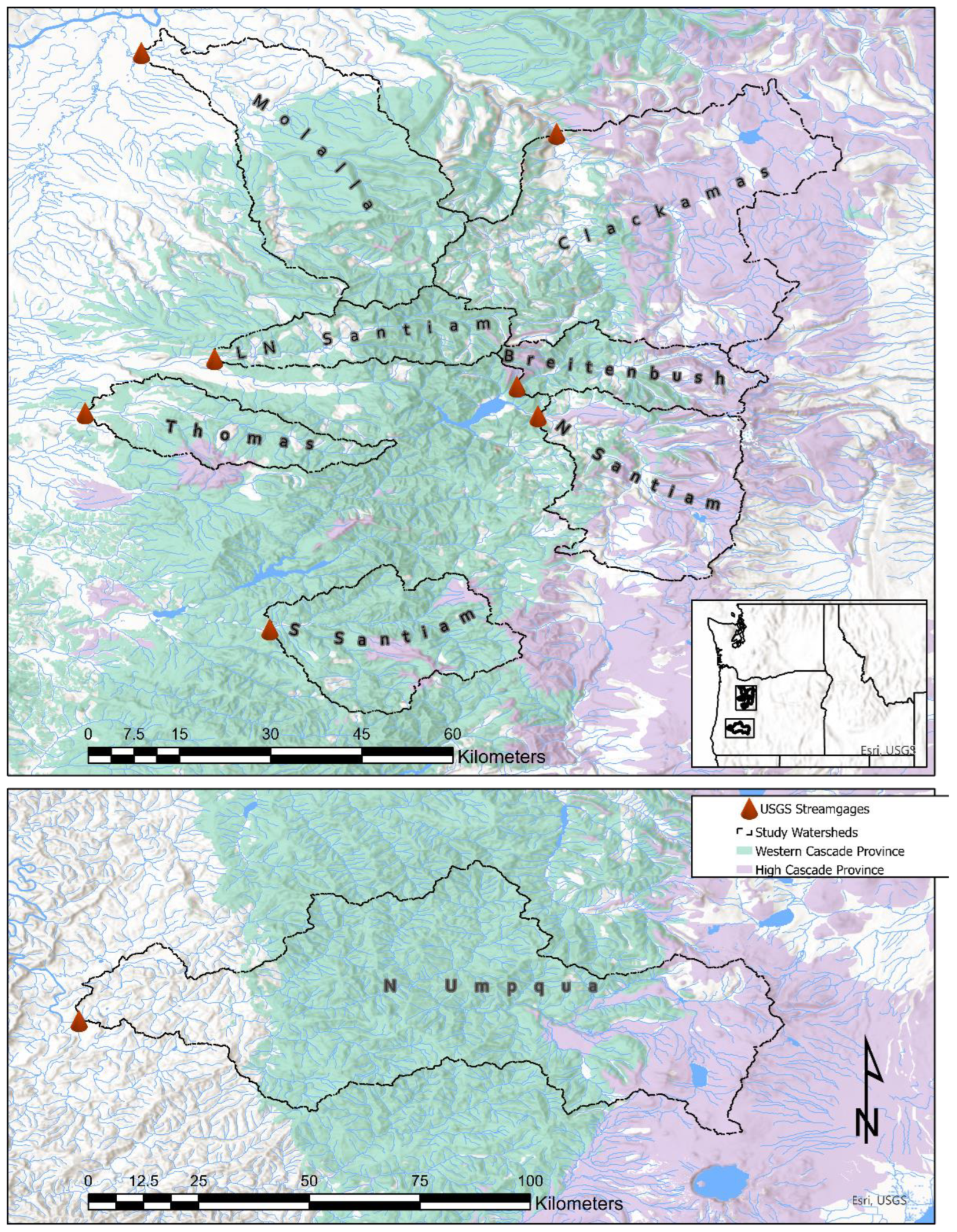
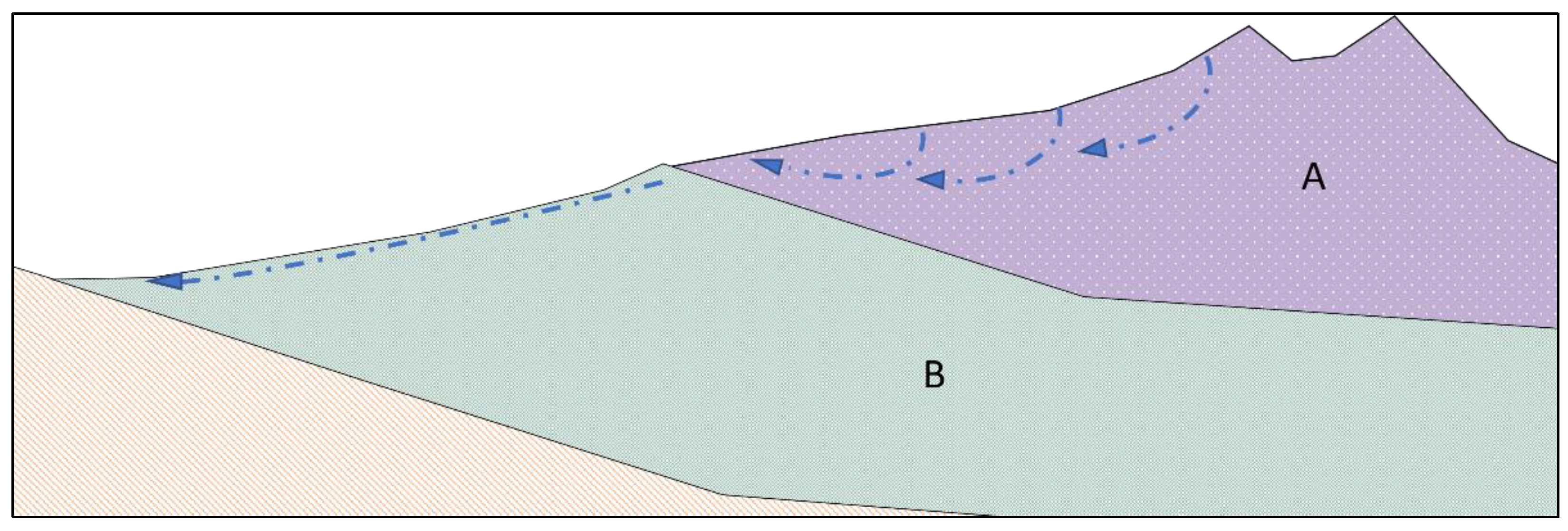
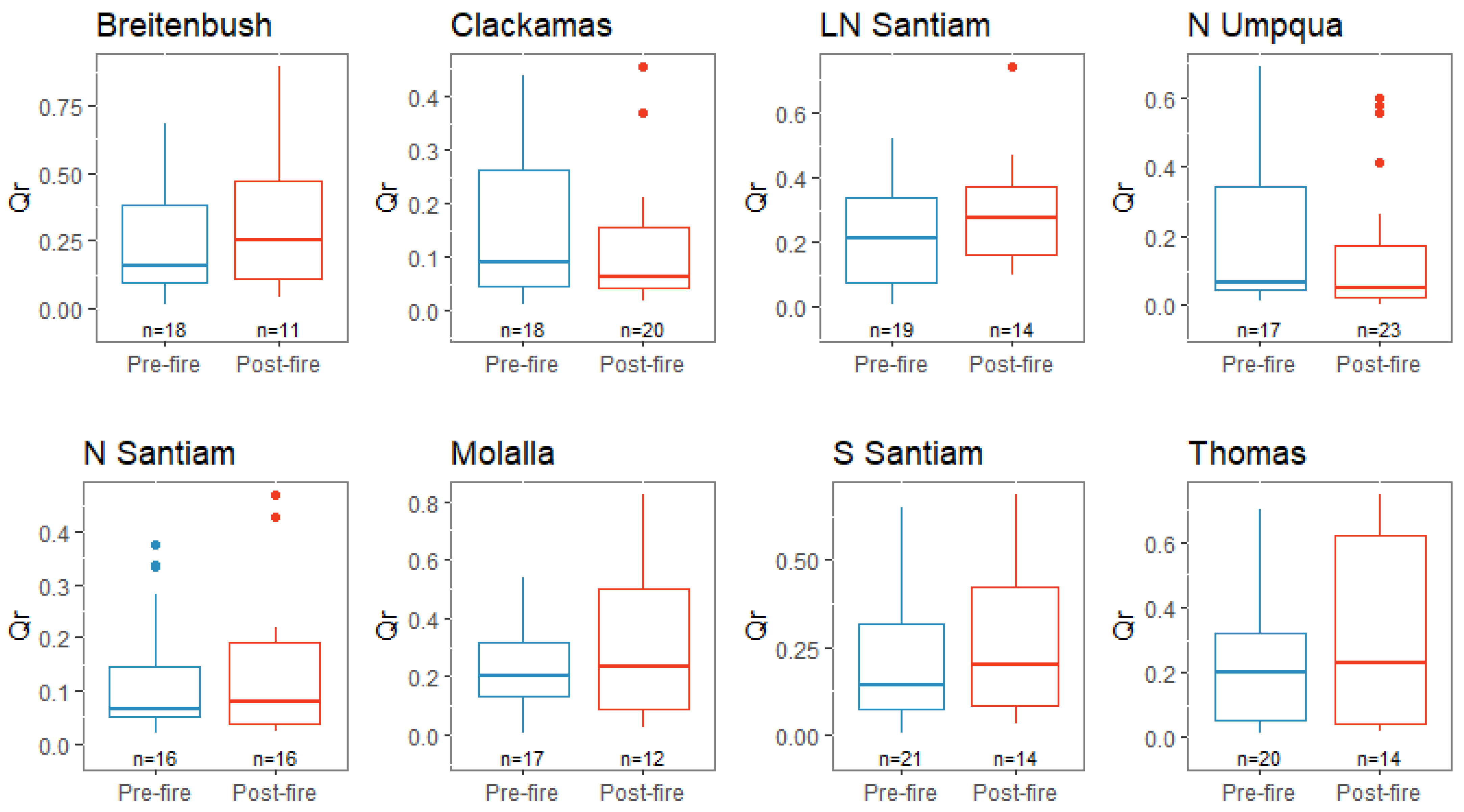
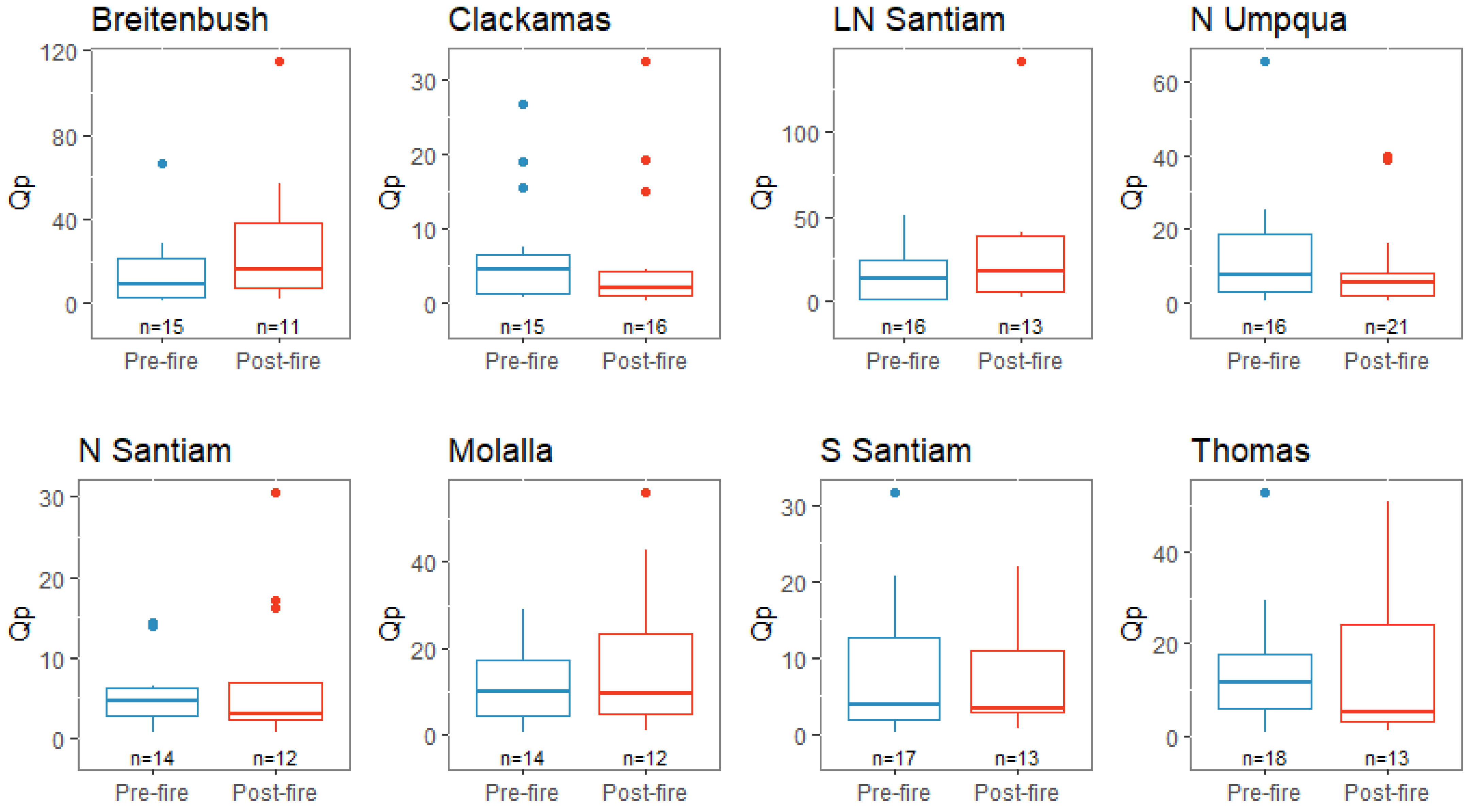


| Watershed | Site Number | Area (Km2) | Total Burned (%) | Low Burned (%) | Moderate Burned (%) | High Burned (%) |
|---|---|---|---|---|---|---|
| Clackamas | 14209500 | 1266 | 11.3 | 6.5 | 3.8 | 1.0 |
| LN Santiam | 14182500 | 287 | 94.0 | 20.7 | 53.4 | 19.9 |
| Breitenbush | 14179000 | 274 | 79.6 | 39.9 | 30.3 | 9.4 |
| N Umpqua | 14319500 | 3515 | 12.9 | 2.9 | 5.5 | 4.5 |
| Molalla | 14200000 | 842 | 36.6 | 16.7 | 17.2 | 2.7 |
| N. Santiam | 14319500 | 558 | 24.9 | 15.9 | 7.3 | 1.7 |
| Site | Burned (%) | LPI | CLUMPY | GYRATE | CONTIG | COHESION |
|---|---|---|---|---|---|---|
| N Umpqua | 12.9 | 11.5 | 0.89 | 57.1 | 0.41 | 99.4 |
| Clackamas | 11.3 | 2.13 | 0.89 | 68.9 | 0.53 | 96.8 |
| N Santiam | 24.9 | 0.70 | 0.87 | 77.2 | 0.57 | 94.5 |
| Molalla | 36.6 | 1.54 | 0.86 | 63.2 | 0.54 | 95.5 |
| Breitenbush | 79.6 | 1.52 | 0.86 | 69.9 | 0.52 | 96.6 |
| LN Santiam | 94.0 | 3.33 | 0.88 | 77.2 | 0.54 | 97.8 |
| Watershed | ∆ Median Qr | IQR Pre-Fire | IQR Post-Fire | n | W | p-Value |
|---|---|---|---|---|---|---|
| N Umpqua (B) | −0.01 | 0.05–0.34 | 0.02–0.17 | 40 | 225 | 0.43 |
| Clackamas (B) | −0.03 | 0.05–0.26 | 0.04–0.16 | 38 | 195 | 0.67 |
| N Santiam (B) | 0.01 | 0.05–0.15 | 0.04–0.19 | 32 | 123 | 0.87 |
| Molalla (B) | 0.04 | 0.13–0.32 | 0.09–0.50 | 29 | 92 | 0.67 |
| Breitenbush (B) | 0.09 | 0.09–0.38 | 0.11–0.47 | 29 | 79 | 0.38 |
| LN Santiam (B) | 0.07 | 0.07–0.34 | 0.16–0.37 | 33 | 103 | 0.28 |
| S Santiam (C) | 0.07 | 0.07–0.32 | 0.08–0.42 | 35 | 127 | 0.51 |
| Thomas (C) | 0.03 | 0.06–0.32 | 0.04–0.62 | 34 | 126 | 0.64 |
| Watershed | ∆ Median Qp | IQR Pre-Fire | IQR Post-Fire | n | W | p-Value |
|---|---|---|---|---|---|---|
| N Umpqua (B) | −1.69 | 3.1–18.4 | 1.9–7.9 | 37 | 196 | 0.40 |
| Clackamas (B) | −2.64 | 1.2–6.5 | 0.9–4.1 | 31 | 147 | 0.29 |
| N Santiam (B) | −1.86 | 2.6–6.2 | 2.3–7.0 | 27 | 108 | 0.42 |
| Molalla (B) | −0.65 | 4.2–17.1 | 4.6–23.4 | 26 | 77 | 0.74 |
| Breitenbush (B) | 6.73 | 2.8–21.8 | 7.1–38.6 | 26 | 58 | 0.21 |
| LN Santiam (B) | 4.48 | 1.8–23.9 | 6.3–38.7 | 29 | 74 | 0.20 |
| S Santiam (C) | −0.46 | 1.9–12.7 | 2.7–10.9 | 30 | 113 | 0.93 |
| Thomas (C) | −6.37 | 6.1–17.8 | 3.2–24.4 | 31 | 132 | 0.56 |
Publisher’s Note: MDPI stays neutral with regard to jurisdictional claims in published maps and institutional affiliations. |
© 2022 by the authors. Licensee MDPI, Basel, Switzerland. This article is an open access article distributed under the terms and conditions of the Creative Commons Attribution (CC BY) license (https://creativecommons.org/licenses/by/4.0/).
Share and Cite
Long, W.B.; Chang, H. Event Scale Analysis of Streamflow Response to Wildfire in Oregon, 2020. Hydrology 2022, 9, 157. https://doi.org/10.3390/hydrology9090157
Long WB, Chang H. Event Scale Analysis of Streamflow Response to Wildfire in Oregon, 2020. Hydrology. 2022; 9(9):157. https://doi.org/10.3390/hydrology9090157
Chicago/Turabian StyleLong, Will B., and Heejun Chang. 2022. "Event Scale Analysis of Streamflow Response to Wildfire in Oregon, 2020" Hydrology 9, no. 9: 157. https://doi.org/10.3390/hydrology9090157
APA StyleLong, W. B., & Chang, H. (2022). Event Scale Analysis of Streamflow Response to Wildfire in Oregon, 2020. Hydrology, 9(9), 157. https://doi.org/10.3390/hydrology9090157






